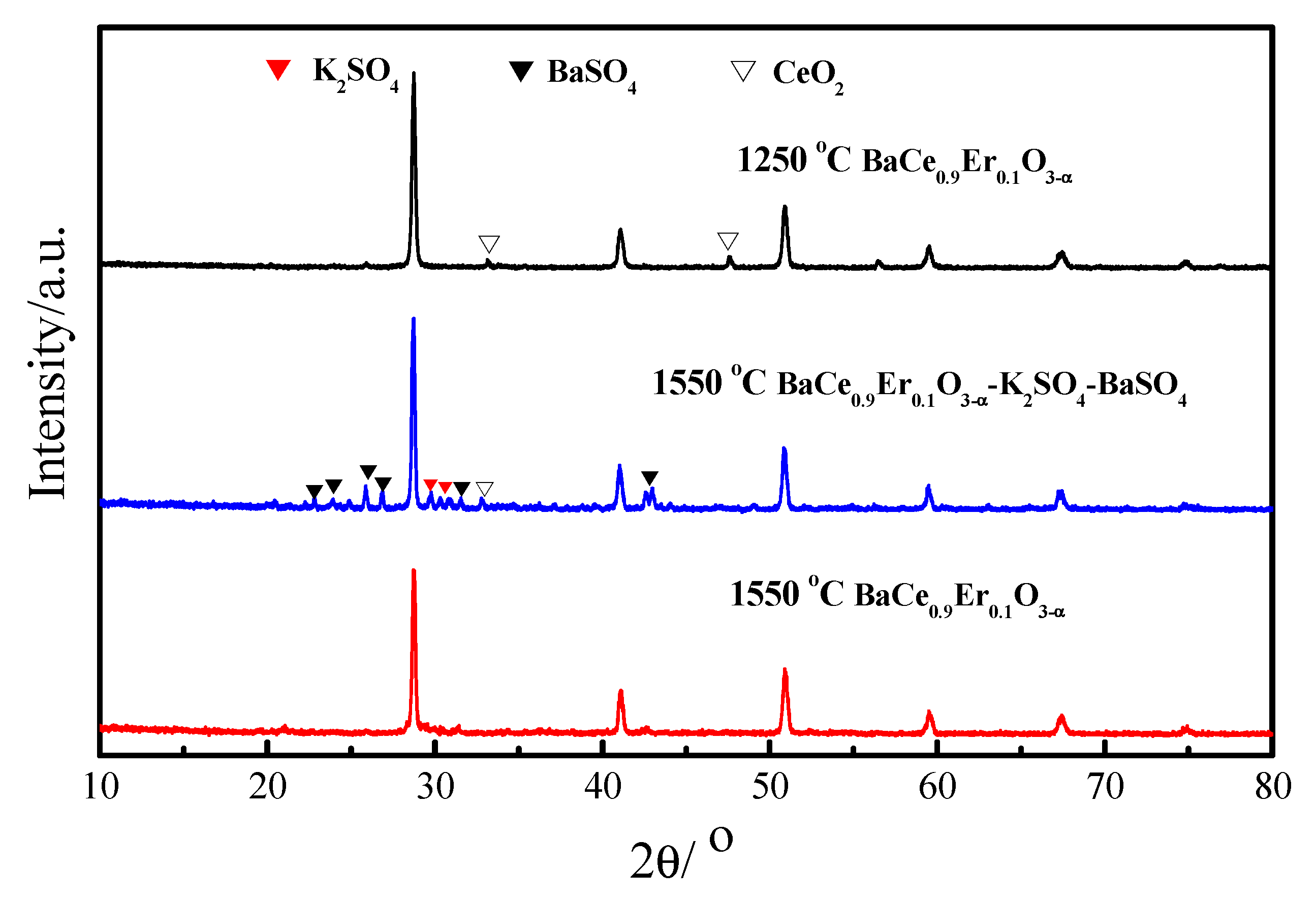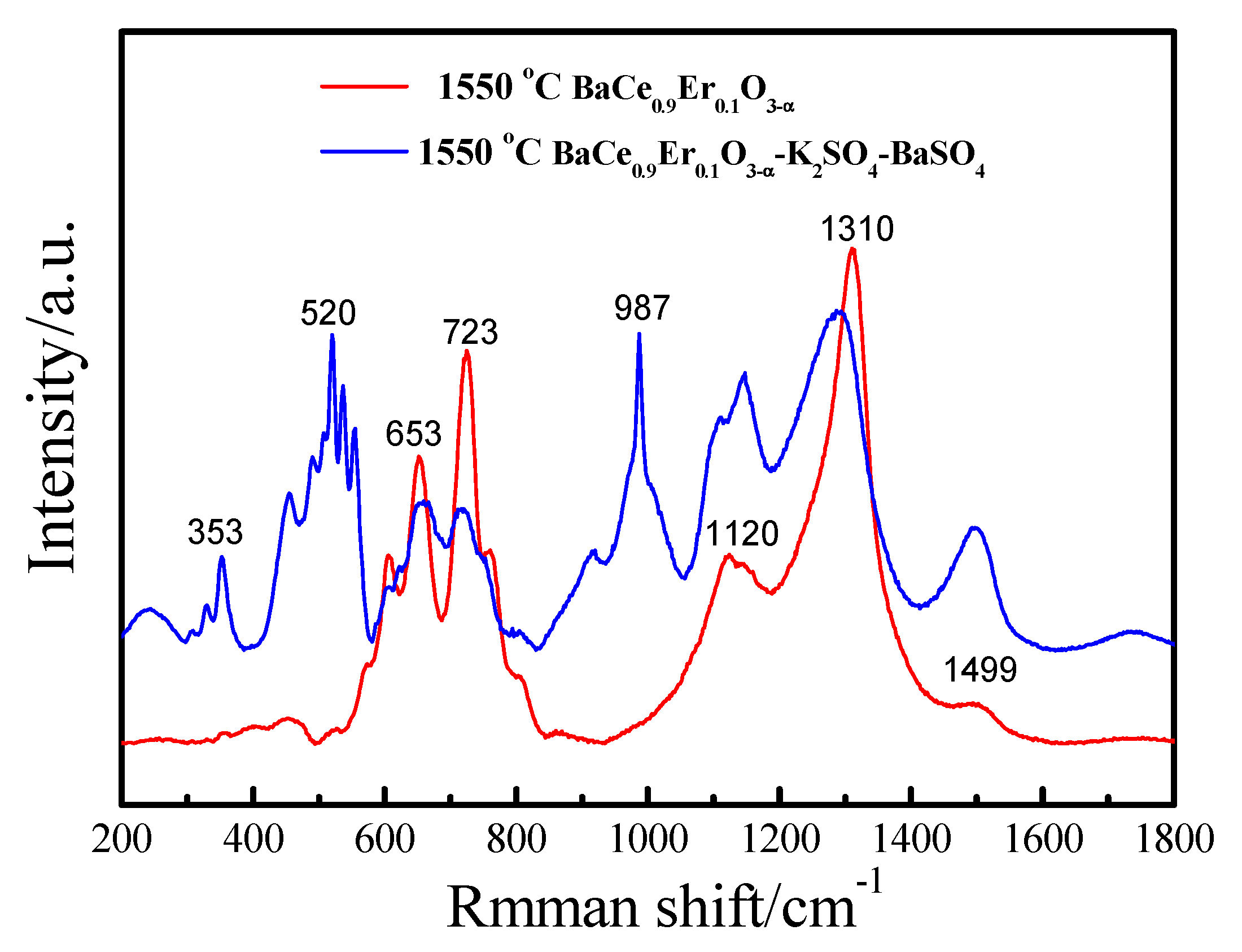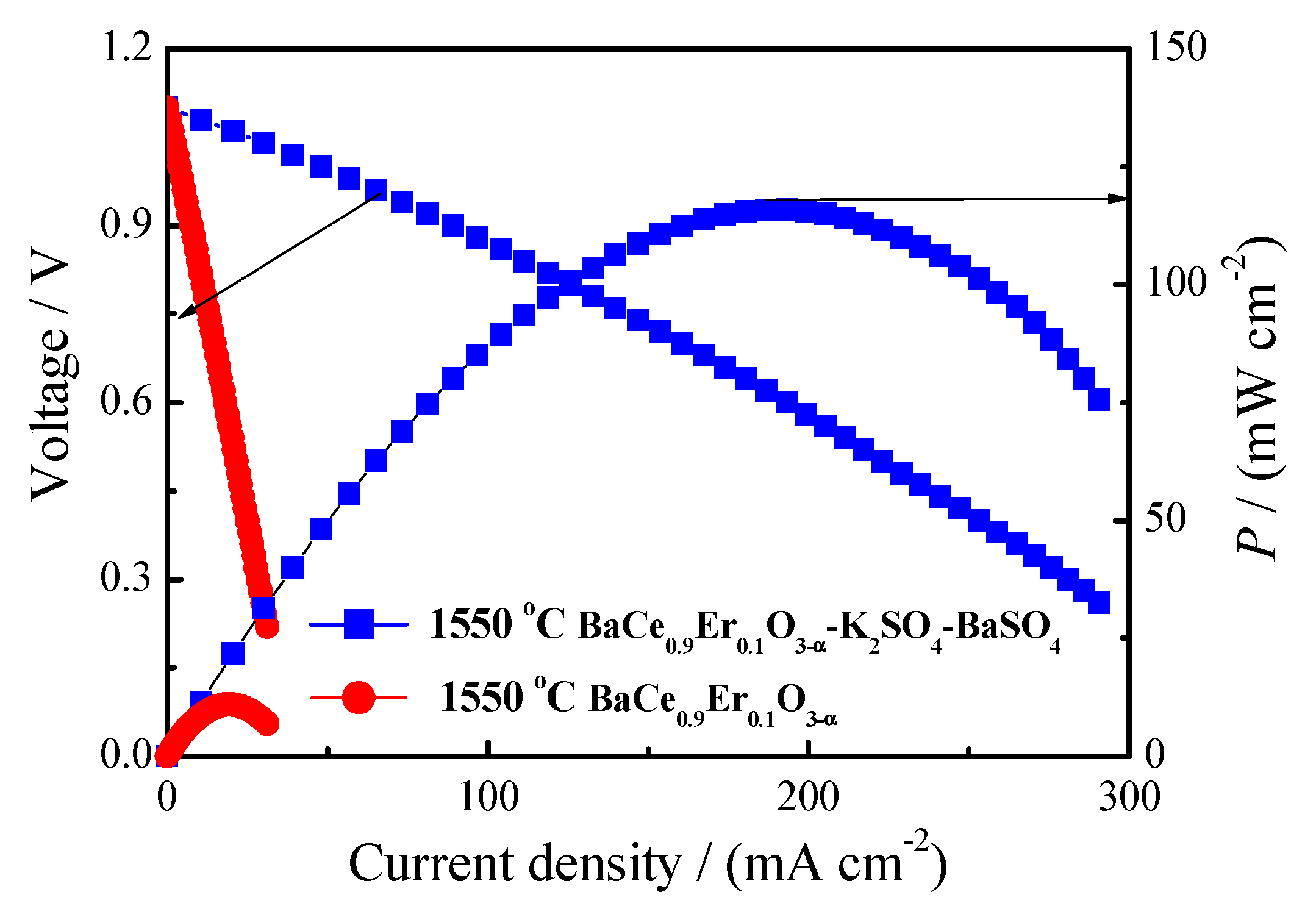Preparation, Characterization and Intermediate-Temperature Electrochemical Properties of Er3+-Doped Barium Cerate–Sulphate Composite Electrolyte
Abstract
:1. Introduction
2. Experimental
3. Results and Discussion
4. Conclusions
Author Contributions
Funding
Conflicts of Interest
References
- Faro, M.L.; Trocino, S.; Zignani, S.C.; Italiano, C.; Vita, A.; Aricò, A.S. Study of a solid oxide fuel cell fed with n-dodecane reformate. Part II: Effect of the reformate composition. Int. J. Hydrog. Energy 2017, 42, 1751–1757. [Google Scholar] [CrossRef]
- Fragiacomo, P.; De Lorenzo, G.; Corigliano, O. Performance analysis of an intermediate temperature solid oxide electrolyzer test bench under a CO2-H2O feed stream. Energies 2018, 11, 2276. [Google Scholar] [CrossRef]
- Tian, Y.; Lü, Z.; Guo, X.; Wu, P. Catalytic activity of Ni-YSZ composite as anode for methane oxidation in solid oxide fuel cells. Int. J. Electrochem. Sci. 2019, 14, 1093–1106. [Google Scholar] [CrossRef]
- Miyake, M.; Matsumoto, S.; Iwami, M.; Nishimoto, S.; Kameshima, Y. Electrochemical performances of Ni1−xCux/SDC cermet anodes for intermediate-temperature SOFCs using syngas fuel. Int. J. Hydrog. Energy 2016, 41, 13625–13631. [Google Scholar] [CrossRef]
- De Lorenzo, G.; Fragiacomo, P. Electrical and thermal analysis of an intermediate temperature IIR-SOFC system fed by biogas. Energy Sci. Eng. 2018, 6, 60–72. [Google Scholar] [CrossRef] [Green Version]
- Milewski, J.; Wołowicz, M.; Lewandowski, J. Comparison of SOE/SOFC system configurations for a peak hydrogen power plant. Int. J. Hydrog. Energy 2017, 42, 3498–3509. [Google Scholar] [CrossRef]
- Kim, H.S.; Bae, H.B.; Jung, W.; Chung, S.Y. Manipulation of nanoscale intergranular phases for high proton conduction and decomposition tolerance in BaCeO3 polycrystals. Nano. Lett. 2018, 18, 1110–1117. [Google Scholar] [CrossRef]
- Gong, Z.; Sun, W.; Jin, Z.; Miao, L.; Liu, W. Barium- and strontium-containing anode materials toward ceria-based solid oxide fuel cells with high open circuit voltages. ACS Appl. Energy Mater. 2018, 1, 3521–3528. [Google Scholar] [CrossRef]
- Pikalova, E.; Medvedev, D. Effect of anode gas mixture humidification on the electrochemical performance of the BaCeO3-based protonic ceramic fuel cell. Int. J. Hydrog. Energy 2016, 41, 4016–4025. [Google Scholar] [CrossRef]
- Bae, S.Y.; Park, J.Y.; Lim, H.T. Investigation of electronic transport property and durability of BCY-BZY electrolyte cells using embedded probes. Electrochim. Acta 2017, 236, 399–407. [Google Scholar] [CrossRef]
- Vilela, C.; Martins, A.P.C.; Sousa, N.; Silvestre, A.J.D.; Figueiredo, F.M.L.; Freire, C.S.R. Poly (bis [2-(methacryloyloxy) ethyl] phosphate)/bacterial cellulose nanocomposites: Preparation, characterization and application as polymer electrolyte membranes. Appl. Sci. 2018, 8, 1145. [Google Scholar] [CrossRef]
- Xia, C.; Qiao, Z.; Feng, C.; Kim, J.; Wang, B.; Zhu, B. Study on zinc oxide-based electrolytes in low-temperature solid oxide fuel cells. Materials 2018, 11, 40. [Google Scholar] [CrossRef]
- Fang, X.; Zhu, J.; Lin, Z. Effects of electrode composition and thickness on the mechanical performance of a solid oxide fuel cell. Energies 2018, 11, 1735. [Google Scholar] [CrossRef]
- Bernuy-Lopez, C.; Rioja-Monllor, L.; Nakamura, T.; Ricote, S.; O’Hayre, R.; Amezawa, K.; Einarsrud, M.; Grande, T. Effect of cation ordering on the performance and chemical stability of layered double perovskite cathodes. Materials 2018, 11, 196. [Google Scholar] [CrossRef]
- Sun, H.; Zhang, S.; Li, C.; Rainwater, B.; Liu, Y.; Zhang, L.; Zhang, Y.; Li, C.; Liu, M. Atmospheric plasma-sprayed BaZr0.1Ce0.7Y0.1Yb0.1O3−δ(BZCYYb) electrolyte membranes for intermediate-temperature solid oxide fuel cells. Ceram. Int. 2016, 42, 19231–19236. [Google Scholar] [CrossRef]
- Danilov, N.; Pikalova, E.; Lyagaeva, J.; Antonov, B.; Medvedev, D.; Demin, A.; Tsiakaras, P. Grain and grain boundary transport in BaCe0.5Zr0.3Ln0.2O3−δ (Ln-Y or lanthanide) electrolytes attractive for protonic ceramic fuel cells application. J. Power Sources 2017, 366, 161–168. [Google Scholar] [CrossRef]
- Xiao, J.; Chen, L.; Yuan, H.; Ji, L.; Xiong, C.; Ma, J.; Zhu, X. Fabrication and characterization of BaZr0.1Ce0.7Y0.2O3−δ based anode supported solid oxide fuel cells by tape casting combined with spray coating. Mater. Lett. 2017, 189, 192–195. [Google Scholar] [CrossRef]
- Lyagaeva, J.; Vdovin, G.; Hakimova, L.; Medvedev, D.; Demin, A.; Tsiakaras, P. BaCe0.5Zr0.3Y0.2–xYbxO3−δ proton-conducting electrolytes for intermediate-temperature solid oxide fuel cells. Electrochim. Acta 2017, 251, 554–561. [Google Scholar] [CrossRef]
- Wang, W.; Medvedev, D.; Shao, Z. Gas humidification impact on the properties and performance of perovskite-type functional materials in proton-conducting solid oxide cells. Adv. Funct. Mater. 2018, 28, 1802592. [Google Scholar] [CrossRef]
- Minakshi, M.; Nallathamby, K.; David, R.G.M. Electrochemical characterization of an aqueous lithium rechargeable battery: The effect of CeO2 additions to the MnO2 cathode. J. Alloy Compd. 2009, 479, 87–90. [Google Scholar] [CrossRef]
- Sun, L.; Miao, H.; Wang, H. Novel SrCe1-xYbxO3-α-(Na/K)Cl composite electrolytes for intermediate temperature solid oxide fuel cells. Solid State Ions. 2017, 311, 41–45. [Google Scholar] [CrossRef]
- Zhang, Z.; Chen, L.; Li, Q.; Song, T.; Su, J.; Cai, B.; He, H. High performance In, Ta and Y-doped BaCeO3 electrolyte membrane for proton-conducting solid oxide fuel cells. Solid State Ions. 2018, 323, 25–31. [Google Scholar] [CrossRef]
- Shi, R.; Liu, J.; Wang, H.; Wu, F.; Miao, H.; Cui, Y. Low temperature synthesis of SrCe0.9Eu0.1O3-α by sol-gel method and SrCe0.9Eu0.1O3-α-NaCl-KCl composite electrolyte for intermediate temperature fuel cells. Int. J. Electrochem. Sci. 2017, 12, 11594–11601. [Google Scholar] [CrossRef]
- Guo, Y.; Liu, B.; Yang, Q.; Chen, C.; Wang, W.; Ma, G. Preparation via microemulsion method and proton conduction at intermediate-temperature of BaCe1-xYxO3-α. Electrochem. Commun. 2009, 11, 153–156. [Google Scholar] [CrossRef]
- Morejudo, S.H.; Zanón, R.; Escolástico, S.; Yuste-Tirados, I.; Malerød-Fjeld, H.; Vestre, P.K.; Coors, W.G.; Martínez, A.; Norby, T.; Serra, J.M.; et al. Direct conversion of methane to aromatics in a catalytic co-ionic membrane reactor. Science 2016, 353, 563–566. [Google Scholar] [CrossRef]
- Duan, C.; Tong, J.; Shang, M.; Nikodemski, S.; Sanders, M.; Ricote, S.; Almonsoori, A.; O’Hayre, R. Readily processed protonic ceramic fuel cells with high performance at low temperatures. Science 2015, 349, 1321–1326. [Google Scholar] [CrossRef]
- Liu, F.; Dang, J.; Hou, J.; Qian, J.; Zhu, Z.; Wang, Z.; Liu, W. Study on new BaCe0.7In0.3O3−δ–Gd0.1Ce0.9O2−δ composite electrolytes for intermediate-temperature solid oxide fuel cells. J. Alloy Compd. 2015, 639, 252–258. [Google Scholar] [CrossRef]
- Park, K.Y.; Lee, T.H.; Jo, S.; Yang, J.; Song, S.J.; Lim, H.T.; Kim, J.H.; Park, J.Y. Electrical and physical properties of composite BaZr0.85Y0.15O3−δ-Nd0.1Ce0.9O2−δ electrolytes for intermediate temperature-solid oxide fuel cells. J. Power Sources 2016, 336, 437–446. [Google Scholar] [CrossRef]
- Li, B.; Liu, S.; Liu, X.; Qi, S.; Yu, J.; Wang, H.; Su, W. Electrical properties of SDC-BCY composite electrolytes for intermediate temperature solid oxide fuel cell. Int. J. Hydrog. Energy 2014, 39, 14376–14380. [Google Scholar] [CrossRef]
- Rondao, A.I.B.; Patricio, S.G.; Figueiredo, F.M.L.; Marques, F.M.B. Composite electrolytes for fuel cells: Long-term stability under variable atmosphere. Int. J. Hydrog. Energy 2014, 39, 5460–5469. [Google Scholar] [CrossRef]
- Martins, N.C.T.; Rajesh, S.; Marques, F.M.B. Synthesis and electrochemical assessment of Ce0.5Yb0.5O1.75 ceramics and derived composite electrolytes. Mater. Res. Bull. 2015, 70, 449–455. [Google Scholar] [CrossRef]
- Park, K.Y.; Lee, T.H.; Kim, J.T.; Lee, N.; Seo, Y.; Song, S.J.; Park, J.Y. Highly conductive barium zirconate-based carbonate composite electrolytes for intermediate temperature-protonic ceramic fuel cells. J. Alloy Compd. 2014, 585, 103–110. [Google Scholar] [CrossRef]
- Hei, Y.; Huang, J.; Wang, C.; Mao, Z. Novel doped barium cerate-carbonate composite electrolyte material for low temperature solid oxide fuel cells. Int. J. Hydrog. Energy 2014, 39, 14328–14333. [Google Scholar] [CrossRef]
- Zhang, W.; Yuan, M.; Wang, H.; Liu, J. High-performance intermediate temperature fuel cells of new SrCe0.9Yb0.1O3-α-inorganic salt composite electrolytes. J. Alloy Compd. 2016, 677, 38–41. [Google Scholar] [CrossRef]
- Shi, R.; Liu, J.; Wang, H.; Wu, F.; Miao, H. Intermediate temperature fuel cell durability of Eu-doped SrCeO3-SrZrO3 solid solution/ NaCl-KCl composite electrolyte. Ceram. Int. 2017, 43, 16931–16935. [Google Scholar] [CrossRef]
- Slim, C.; Baklouti, L.; Cassir, M.; Ringuedé, A. Structural and electrochemical performance of gadolinia-doped ceria mixed with alkali chlorides (LiCl-KCl) for Intermediate Temperature-Hybrid Fuel Cell applications. Electrochim. Acta 2014, 123, 127–134. [Google Scholar] [CrossRef]
- Yao, C.; Meng, J.; Liu, X.; Zhang, X.; Liu, X.; Meng, F.; Wu, X.; Meng, J. Enhanced ionic conductivity in Gd-doped ceria and (Li/Na)2SO4 composite electrolytes for solid oxide fuel cells. Solid State Sci. 2015, 49, 90–96. [Google Scholar] [CrossRef]
- Song, J.; Meng, B.; Tan, X. Stability and electrical conductivity of BaCe0.85Tb0.05M0.1O3-δ (M = Co, Fe, Y, Zr, Mn) high temperature proton conductors. Ceram. Int. 2016, 42, 13278–13284. [Google Scholar] [CrossRef]
- Reddy, G.S.; Bauri, R. Y and In-doped BaCeO3-BaZrO3 solid solutions: Chemically stable and easily sinterable proton conducting oxides. J. Alloy Compd. 2016, 688, 1039–1046. [Google Scholar] [CrossRef]
- Liu, X.; Fechler, N.; Antonietti, M. Salt melt synthesis of ceramics, semiconductors and carbon nanostructures. Chem. Soc. Rev. 2013, 42, 8237–8265. [Google Scholar] [CrossRef] [Green Version]
- Wang, H.; Liu, J. Low temperature synthesis of novel SrCe0.9Yb0.1O3-α-chlorides composite electrolytes for intermediate temperature protonic ceramics fuel cells. Ceram. Int. 2016, 42, 18136–18140. [Google Scholar] [CrossRef]
- Phokha, S.; Hunpratub, S.; Usher, B.; Pimsawat, A.; Chanlek, N.; Maensiri, S. Effects of CeO2 nanoparticles on electrochemical properties of carbon/CeO2 composites. Appl. Surf. Sci. 2018, 446, 36–46. [Google Scholar] [CrossRef]
- Preethi, S.; Abhiroop, M.; Babu, K.S. Low temperature densification by lithium co-doping and its effect on ionic conductivity of samarium doped ceria electrolyte. Ceram. Int. 2019, 45, 5819–5828. [Google Scholar] [CrossRef]
- Hou, Y.; Wu, J.; Konysheva, E.Y. Quantitative characterization of Cr-adsorption on CeO2, pure and doped BaCeO3 and its impact on the electrochemical performance of Ce containing complex oxides. Int. J. Hydrog. Energy 2016, 41, 3994–4004. [Google Scholar] [CrossRef]
- Huang, J.; Mao, Z.; Liu, Z.; Wang, C. Performance of fuel cells with proton-conducting ceria-based composite electrolyte and nickel-based electrodes. J. Power Sources 2008, 175, 238–243. [Google Scholar] [CrossRef]







© 2019 by the authors. Licensee MDPI, Basel, Switzerland. This article is an open access article distributed under the terms and conditions of the Creative Commons Attribution (CC BY) license (http://creativecommons.org/licenses/by/4.0/).
Share and Cite
Wu, F.; Du, R.; Hu, T.; Zhai, H.; Wang, H. Preparation, Characterization and Intermediate-Temperature Electrochemical Properties of Er3+-Doped Barium Cerate–Sulphate Composite Electrolyte. Materials 2019, 12, 2752. https://doi.org/10.3390/ma12172752
Wu F, Du R, Hu T, Zhai H, Wang H. Preparation, Characterization and Intermediate-Temperature Electrochemical Properties of Er3+-Doped Barium Cerate–Sulphate Composite Electrolyte. Materials. 2019; 12(17):2752. https://doi.org/10.3390/ma12172752
Chicago/Turabian StyleWu, Fufang, Ruifeng Du, Tianhui Hu, Hongbin Zhai, and Hongtao Wang. 2019. "Preparation, Characterization and Intermediate-Temperature Electrochemical Properties of Er3+-Doped Barium Cerate–Sulphate Composite Electrolyte" Materials 12, no. 17: 2752. https://doi.org/10.3390/ma12172752




